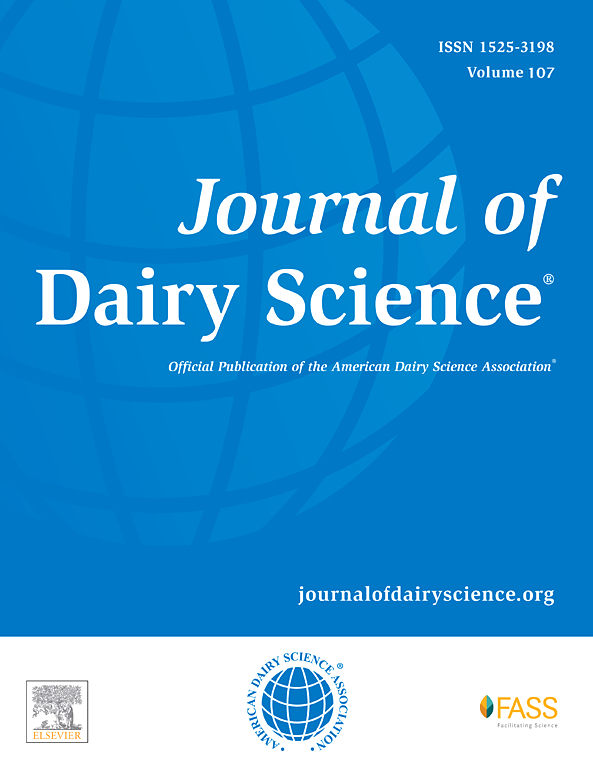Proteomics and surface free fatty acid analysis of milk fat globules in spray- and freeze-dried bovine, goat, and horse milk powders
IF 3.7
1区 农林科学
Q1 AGRICULTURE, DAIRY & ANIMAL SCIENCE
引用次数: 0
Abstract
Changes in the structure and composition of milk fat globules in spray- and freeze-dried milk powders have recently garnered notable attention. This study investigated changes in milk fat globular membrane (MFGM) proteins from bovine, goat, and horse milk powders, both spray- and freeze-dried, using a label-free proteomic approach, and quantified surface free fatty acids and their composition using GC. The results showed that several proteins, including αS2-CN and β-LG, increased, whereas fibrinogen α and β chain and mucin-1 decreased in the MFGM fractions of the studied spray-dried milk powders. Additionally, lactoperoxidase and polymeric immunoglobulin receptor levels were elevated in the studied freeze-dried milk powders. Several proteins exhibited variations in both dried milk powders depending on the species; of these, nucleobindin-1, complement C3, and sulfhydryl oxidase were increased in spray-dried bovine and goat milk powders, and lactoferrin was increased in freeze-dried horse milk powder, compared with their raw milk counterparts. Conversely, butyrophilin subfamily 1 member A1 and xanthine dehydrogenase/oxidase were decreased in spray-dried bovine and goat milk powders, S100 calcium-binding protein and aldehyde dehydrogenase were decreased in freeze-dried bovine and goat milk powders, and mucin-4 and paraoxonase were decreased in horse milk powder. Additionally, spray-dried milk powders had lower surface free fatty acid contents than freeze-dried milk powders. The findings underscore that drying methods exert varied effects on MFGM components of the studied milk sources, thereby providing a valuable reference for improving the nutritional quality of dried dairy products.
喷雾和冻干牛、山羊和马奶粉中乳脂球的蛋白质组学和表面游离脂肪酸分析。
喷雾干燥和冷冻干燥奶粉中乳脂球结构和组成的变化最近引起了广泛关注。本研究采用无标记蛋白质组学方法研究了喷雾干燥和冷冻干燥的牛、山羊和马奶粉中乳脂肪球膜(MFGM)蛋白质的变化,并采用气相色谱法定量分析了表面游离脂肪酸及其组成。结果表明,在所研究的喷雾干燥奶粉的 MFGM 产物中,αS2-酪蛋白和 β-乳球蛋白等几种蛋白质增加了,而纤维蛋白原 α、β 链和粘蛋白-1 则减少了。此外,所研究的冻干奶粉中乳过氧化物酶和聚合免疫球蛋白受体水平升高。与原料奶相比,两种奶粉中的几种蛋白质因品种不同而表现出差异,其中,喷雾干燥牛奶粉和山羊奶粉中的核结合蛋白-1、补体C3和巯基氧化酶含量升高,而冻干马奶粉中的乳铁蛋白含量升高。相反,喷雾干燥牛奶粉和山羊奶粉中的丁淀粉蛋白亚家族 1 成员 A1 和黄嘌呤脱氢酶/氧化酶含量降低,冻干牛奶粉和山羊奶粉中的 S100 钙结合蛋白和醛脱氢酶含量降低,马奶粉中的粘蛋白-4 和对氧磷酶含量降低。此外,与冻干奶粉相比,喷雾干燥奶粉的表面游离脂肪酸含量较低。研究结果表明,干燥方法对所研究奶源的 MFGM 成分有不同的影响,从而为提高奶制品的营养质量提供了有价值的参考。
本文章由计算机程序翻译,如有差异,请以英文原文为准。
求助全文
约1分钟内获得全文
求助全文
来源期刊

Journal of Dairy Science
农林科学-奶制品与动物科学
CiteScore
7.90
自引率
17.10%
发文量
784
审稿时长
4.2 months
期刊介绍:
The official journal of the American Dairy Science Association®, Journal of Dairy Science® (JDS) is the leading peer-reviewed general dairy research journal in the world. JDS readers represent education, industry, and government agencies in more than 70 countries with interests in biochemistry, breeding, economics, engineering, environment, food science, genetics, microbiology, nutrition, pathology, physiology, processing, public health, quality assurance, and sanitation.
 求助内容:
求助内容: 应助结果提醒方式:
应助结果提醒方式:


